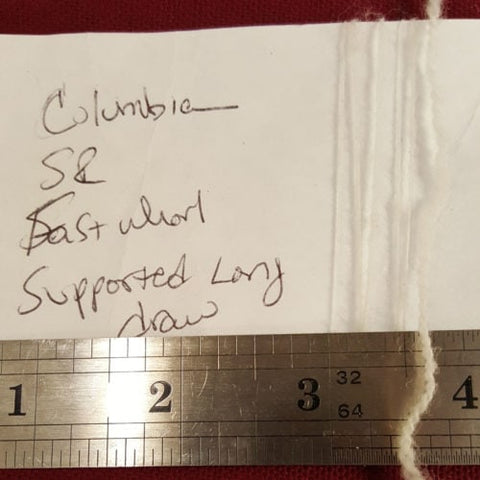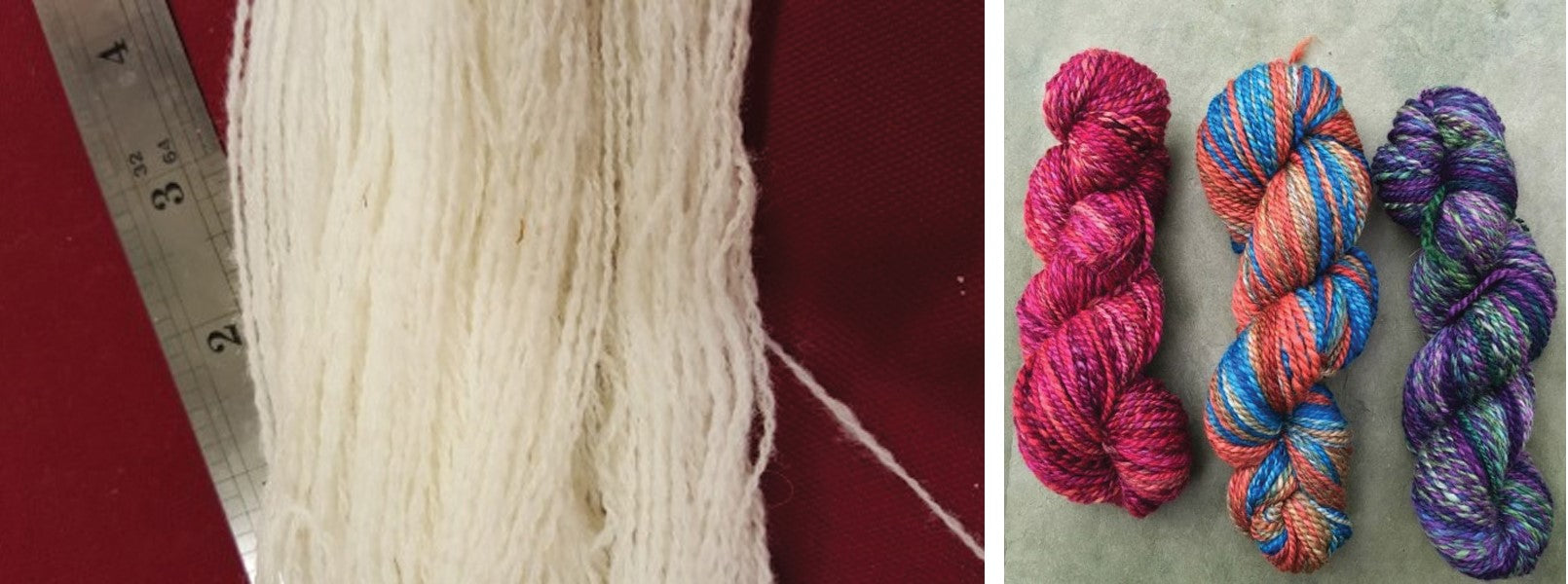
Beth Smith and Jillian Moreno live about 30 minutes from each other and spend a lot of spinning time together, trading ideas and cheering each other on. Recently, the two have found weaving sneaking into their thoughts more and more. “Wouldn’t it be fun,” they said, “to do a project where we spin our yarn and weave it and see what happens?” “Yes!” they said, “that sounds like an awesome plan.” We thought so, too. Through the end of the year, they will post on the Schacht Spindle blog, telling you about their journey weaving with handspun on a rigid heddle loom.
Beth
Now that you've seen the sampling I did, how about some detail about the yarn? It's important to sample your yarns and even make samples of different yarn that you make in order to be sure that it’s going to work. By work, I mean is it making the fabric you want? Does it drape well if drape is what you want? Does it stand up to abrasion if hard wearing is what you want? Is it soft enough if soft is what you want? Sampling is the key. Taking your newly woven fabric all the way to a finished fabric is important because that sample, right as it comes off the loom, is not the finished fabric.

But I’m getting off the real topic of this post...
For this project I was really interested in whether the yarn would have to be spun in any special way for weaving. So many times I’ve read that it’s important to add extra twist when spinning yarn for warp. But then Sara Lamb came right out and told me that that’s a bunch of hooey. So, who was right: the whole entire internet? Or Sara Lamb, who actually spins for weaving all the time?
So, I decided to spin a low twist woolen yarn. I know! Low twist AND woolen. Let’s look at the yarn.
The plied yarn ended up to be about 18 wraps per inch with about 5 twists per inch. That is very low twist for this particular wool though the yarn is balanced.

Check out how the yarn blooms. The photo below is of my sample card that I made at the very beginning of my spinning. It allows me to compare the singles I’m making with the singles on the card to make sure I’m staying pretty consistent over the entire project. I also add plied yarns to the card so that when it is time to ply, I have a sample of fresh yarn plied back on itself. That way I can use the ply twist as a reference.

The great thing about all of this experimenting was that I found out that Sara Lamb is right. But she already knew that. Once I put this low twist woolen spun (supported long draw) yarn on the loom, it all worked out.
Jillian
When I spin yarn for a particular project I always walk myself through the "Big 5" - the 5 things that affect my finished yarn: fiber, preparation, draft, ply, and finish. Each one of these elements of building a yarn influences how a yarn looks and behaves when it’s finished and used.
Most of my spinning-for-a-project experience comes from knitting, but a lot of that thinking translates well to weaving too. The project I am making is a mobius wrap. I want it to be warm, have some drape, and be woven from a worsted-size yarn.

Here’s how my brain worked through the Big 5 for this:
Fiber – I chose wool for warmth and, in particular, BFL for its durability and drape. Plus, it's an easy quick spin for me.
Preparation – I’m using top because that’s what was available in the colors I liked. I also like how colors look more saturated on top.
Draft – Woolen draft for this project to add air to the top and the BFL, and at a wpi that will finish to a worsted weight 2-ply.
Ply – 2-plied to balance, and maybe a little under. 2-ply is better than a single for durability and to mix up the colors. A little underplied for lightness and drape. In the photo below, my plyback sample is on the right and my plied sample is on the left.

Finish – I whacked my yarns to bring up loft and fuzz and to make them as plump as they wanted to be. The yarn on the top is unfinished and the bottom yarn is soaked in hot water and whacked enough to scare the neighbors.

Here are my yarn stats:
Red yarn: 159 yards
Orange yarn: 179 yards
Green yarn: 178 yards
Finished WPI 8-10
485 yards total needed (261 yards warp, 224 yards weft)
I have 516 yards, so I’m good!

I also want my project to be colorful. That’s a branch of thinking I keep separate from the Big 5, because it’s so big and varied on its own! For this project I’m using three different variegated tops, all dyed by the same dyer, Woolgatherings. They are variegated but not dyed in any particular repeating pattern, and the three have some color commonality. I do not have a plan for how I’ll use the colors; I’ll figure it out as I warp. Maybe that is a mistake, but I’m pleading blissful ignorance on this first project.
So now on to warping and weaving. All of my calculations are based on a sett of 8 epi, but now I’m considering using 5. I want drape, and I know that the fibers of the BFL will hold nicely even at a sett of 5. Or I could use a sett of 8 and beat it lighter. What will I do? That’s for the next blog post!
Update: I have finished weaving my remembering-to-weave scarf. I can't bring myself to throw it in the washer yet, but I will. I was so happy with how it all got easier once I quit thinking so hard about it, and quit trying to make rigid heddle weaving like floor loom weaving. Here's a quick prefinishing photo:


